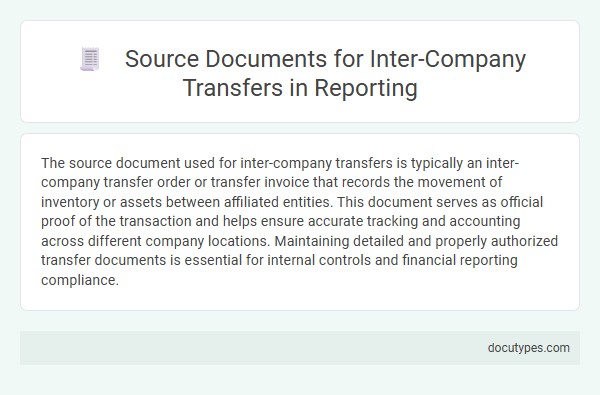The source document used for inter-company transfers is typically an inter-company transfer order or transfer invoice that records the movement of inventory or assets between affiliated entities. This document serves as official proof of the transaction and helps ensure accurate tracking and accounting across different company locations. Maintaining detailed and properly authorized transfer documents is essential for internal controls and financial reporting compliance.
Introduction to Source Documents in Inter-Company Transfers
Source documents play a crucial role in recording inter-company transfers, ensuring accuracy and transparency in financial transactions between related entities. These documents provide detailed evidence of the transfer, supporting accounting and audit processes.
Your inter-company transfers commonly use transfer invoices or inter-company transfer forms as primary source documents. These documents outline the specifics of the transaction, such as quantity, value, and involved parties, facilitating proper documentation and reconciliation.
Importance of Accurate Documentation in Reporting
What type of source document is used for inter-company transfers? Inter-company transfer documents, such as transfer invoices or internal transfer forms, serve as the primary source documents in these transactions. Accurate documentation ensures transparency and consistency in financial reporting across affiliated entities.
Common Types of Source Documents Used
Inter-company transfers require precise documentation to ensure accurate record-keeping and compliance. Understanding the common types of source documents used streamlines your audit and reconciliation processes.
- Transfer Order - A document authorizing the movement of goods or assets between company divisions or subsidiaries.
- Delivery Note - Confirms the receipt of transferred items at the destination location within the organization.
- Intercompany Invoice - Used to record the financial transaction and cost allocation between related entities.
Choosing the correct source document helps maintain transparency and traceability in inter-company transfers.
Key Information Required in Transfer Documents
Inter-company transfers typically use transfer documents such as inter-company invoices, transfer memos, or stock transfer forms. These documents must include key information like the description of goods or services, quantities involved, transfer dates, and the names of the sending and receiving entities. You should ensure that transfer documents also detail pricing, cost centers, and approval signatures to maintain clear and accurate records for accounting and auditing purposes.
Invoice Documentation and Its Role
Inter-company transfers require accurate source documents to ensure proper accounting and compliance. Invoice documentation plays a critical role in verifying and recording these internal transactions.
- Invoice Documentation - Serves as the primary source document for inter-company transfers, detailing the goods or services exchanged between subsidiaries.
- Verification of Transaction Details - Ensures quantities, prices, and terms are clearly defined to maintain consistency across company records.
- Audit and Compliance - Provides an essential audit trail for financial reporting and regulatory requirements within corporate groups.
Delivery Notes and Goods Receipt Acknowledgements
Inter-company transfers require precise documentation to ensure accurate tracking and accounting of goods moved between entities. Delivery Notes and Goods Receipt Acknowledgements serve as critical source documents in this process.
- Delivery Notes - These documents detail the items being transferred, including quantities and descriptions, acting as proof of dispatch from the sending company.
- Goods Receipt Acknowledgements - This document confirms the receipt of goods by the receiving company, verifying that the shipment matches the delivery note.
- Source Document Role - Both documents together provide essential evidence for recording inventory movements and financial transactions within your inter-company systems.
Inter-Company Transfer Orders: Structure and Usage
Inter-company transfer orders serve as the primary source documents for recording and authorizing the movement of inventory between different entities within the same organization. These documents detail the items being transferred, quantities, and the involved company codes, ensuring accuracy in inventory management and financial reconciliation.
The structure of inter-company transfer orders typically includes fields for item descriptions, source and destination locations, transfer dates, and approval signatures. Usage of these orders facilitates transparent tracking, compliance with internal controls, and seamless integration with accounting and warehouse management systems.
Supporting Documents for Regulatory Compliance
Inter-company transfers require specific source documents for accurate tracking and regulatory compliance. Commonly used documents include transfer orders, inter-company invoices, and shipping manifests.
Supporting documents play a critical role in regulatory compliance by providing proof of transaction authenticity and movement of goods between entities. Transfer orders outline the details and authorization of the transfer. Inter-company invoices facilitate internal billing and audit trails, while shipping manifests confirm the physical shipment and receipt of goods.
Document Retention and Audit Trails
| Type of Source Document | Inter-company Transfer Document (ICTD) |
|---|---|
| Purpose | Records transfer of goods, services, or assets between related company entities |
| Key Components | Transfer date, item description, quantity, value, sending and receiving entities, authorization signatures |
| Document Retention Requirements | Retention period typically ranges from 5 to 7 years depending on jurisdiction and corporate policy |
| Importance of Document Retention | Ensures compliance with tax laws, supports financial accuracy, and facilitates internal and external audits |
| Audit Trail Characteristics | Maintains a clear sequence of transactions; includes source document, approvals, ledger entries, and reconciliation records |
| Systems Utilized | Enterprise Resource Planning (ERP) software often integrates electronic document storage and tracking features |
| Benefits for Audit | Enables verification of inter-company transactions; reduces risk of discrepancies and financial statement errors |
What Type of Source Document Is Used for Inter-Company Transfers? Infographic

